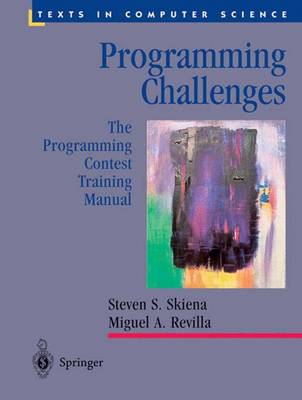Texts in Computer Science
2 total works
There are many distinct pleasures associated with computer programming. Craftsmanship has its quiet rewards, the satisfaction that comes from building a useful object and making it work. Excitement arrives with the flash of insight that cracks a previously intractable problem. The spiritual quest for elegance can turn the hacker into an artist. There are pleasures in parsimony, in squeezing the last drop of performance out of clever algorithms and tight coding.
The games, puzzles, and challenges of problems from international programming competitions are a great way to experience these pleasures while improving your algorithmic and coding skills. This book contains over 100 problems that have appeared in previous programming contests, along with discussions of the theory and ideas necessary to attack them. Instant onlinegrading for all of these problems is available from two WWW robot judging sites. Combining this book with a judge gives an exciting new way to challenge and improve your programming skills.
This book can be used for self-study, for teaching innovative courses in algorithms and programming, and in training for international competition.
The problems in this book have been selected from over 1,000 programming problems at the Universidad de Valladolid online judge. The judge has ruled on well over one million submissions from 27,000 registered users around the world to date. We have taken only the best of the best, the most fun, exciting, and interesting problems available.
This newly expanded and updated second edition of the best-selling classic continues to take the "mystery" out of designing algorithms, and analyzing their efficacy and efficiency. Expanding on the first edition, the book now serves as the primary textbook of choice for algorithm design courses while maintaining its status as the premier practical reference guide to algorithms for programmers, researchers, and students.
The reader-friendly Algorithm Design Manual provides straightforward access to combinatorial algorithms technology, stressing design over analysis. The first part, Techniques, provides accessible instruction on methods for designing and analyzing computer algorithms. The second part, Resources, is intended for browsing and reference, and comprises the catalog of algorithmic resources, implementations and an extensive bibliography. NEW to the second edition:• Doubles the tutorial material and exercises over the first edition
• Provides full online support for lecturers, and a completely updated and improved website component with lecture slides, audio and video
• Contains a unique catalog identifying the 75 algorithmic problems that arise most often in practice, leading the reader down the right path to solve them• Includes several NEW "war stories" relating experiences from real-world applications
• Provides up-to-date links leading to the very best algorithm implementations available in C, C++, and Java
